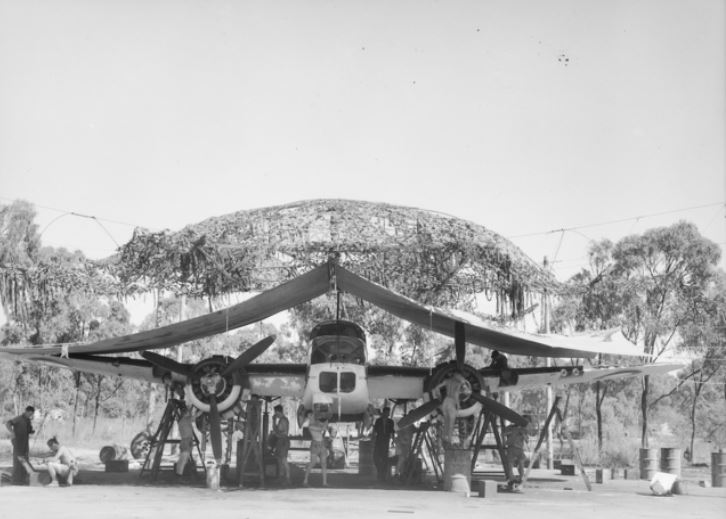No. 7 Squadron RAAF
From Our Contribution
 Beaufort being serviced at Ross River AWM NEA0032 | |
Brief History
This unit \was formed on 24 Oct 1917 as a training squadron based in the Un1ted Kingdom to train officers of the Australian Flying Corps. With the end of the Great War 7 Squadron was disbanded. It was reformed at Laverton on 27 Jun 1940. The intentin was to equip the Squadron with Hudson aircraft but for 18 months the Squadron had no aircraft, and only a handful or airmen who were working with No. 2 Squadron to gain experience.
On 7 Jan 1942 the Squadron was reorganised into three flights and a headquarters. The Squadron remained based at Laverton but its role had been temporarily changed to an Operational Training Unit with the first flight flown on 12 Feb 1942. During March and April 1942 they undertook operational anti submarine patrols before moving base to Bairnsdale, Victoria during May. On 4 Ju 1942 an aircraft on patrol observed a submarine torpedoing a merchant ship and attacked it with unknown outcome. Their next move in July and August was to Nowra, and they were re-equipped with Beaufort aircraft, finishing ther conversion by early October by which time they had relocated to Ross River in Townsville. On 15 Dec 1942 one of their aircraft attacked a submarine north of the Gulf of Carpeneria, again likely to have caused damage, but not necessarily destroying it.
From January to June 1943 No. 7 Squadron detachments at Horn Island and Wards Strip, patrolled uneventfully over the north-eastern coast of Queensland and Torres Strait providing support for local shipping and on watch for enemy submarines. On 18 June, a Japanese Navy reconnaissance float plane, was shot down. Monotonous yet necessary reconnaissance patrols and convoy escort duties continued in the following monthswith further 'Jake' float planes shot down on 20 Sep 1943 and 11 Nov 1943. No. 7 Squadron's first bombing mission was on 27 Nov 1943. Five Beauforts from Horn Island participated in a low level bombing and strafing raid on Kokenau, Timoeka and Keaukiva. All aircraft returned to Hoirn Island.
In March 1944 the squadron moved to Higgins Field from where they flew joint operations with aircraft from other squadrons. Between August and November 1944 the squadrn was inoperational, preparing for a move to New Guinea, and on 29 October it had established itself at Tadji, New Guinea and was again operational by 3 Nov 1944 when Beauforts carried out targets of opportunity missions between Niap and Wewak. Several days later they attacked transport targets on a Japanese airstrip. A period then followed with the aircraft working in close support of Army units until 15 Aug 1945 when it carriedout it's final mission of the war shortly before news of the Japanese surrender was received. Soon after the Squadron aircraft wqere flown back to Australia and the unit was disbanded on 19 Dec 1945.
Ground Crew
- Edgar John Gale 19 Sep 1942 - 19 Dec 1944
Notes
Content has come from Units of the Royal Australian Air Force - A Concise History - Volume 3 Bomber Units - Australian Government Publishing Service - 1995 pages 22 - 26